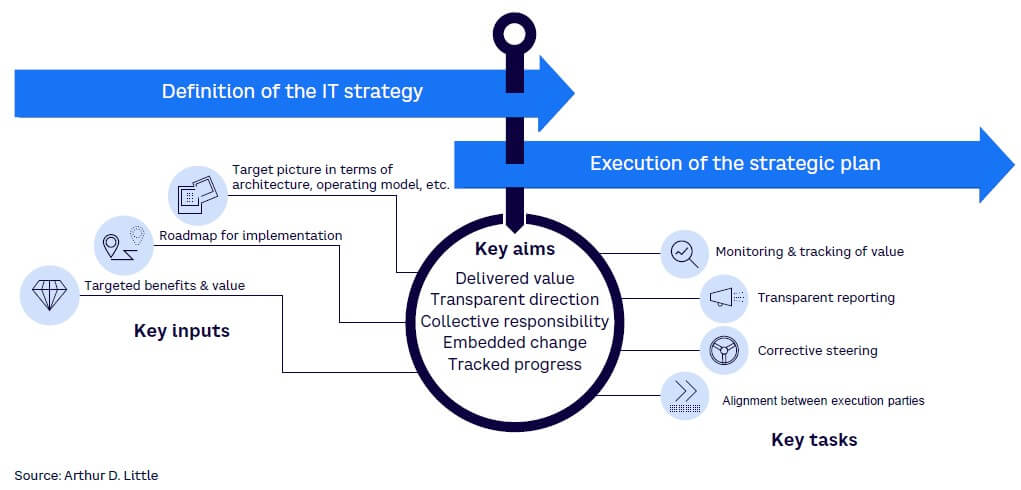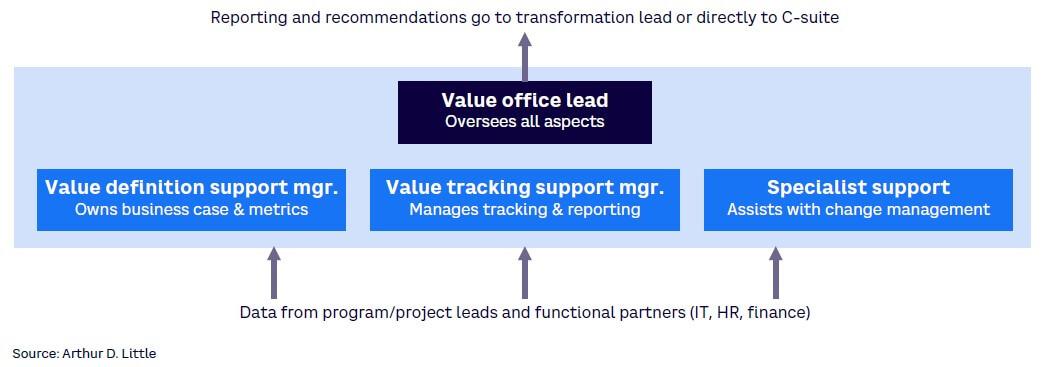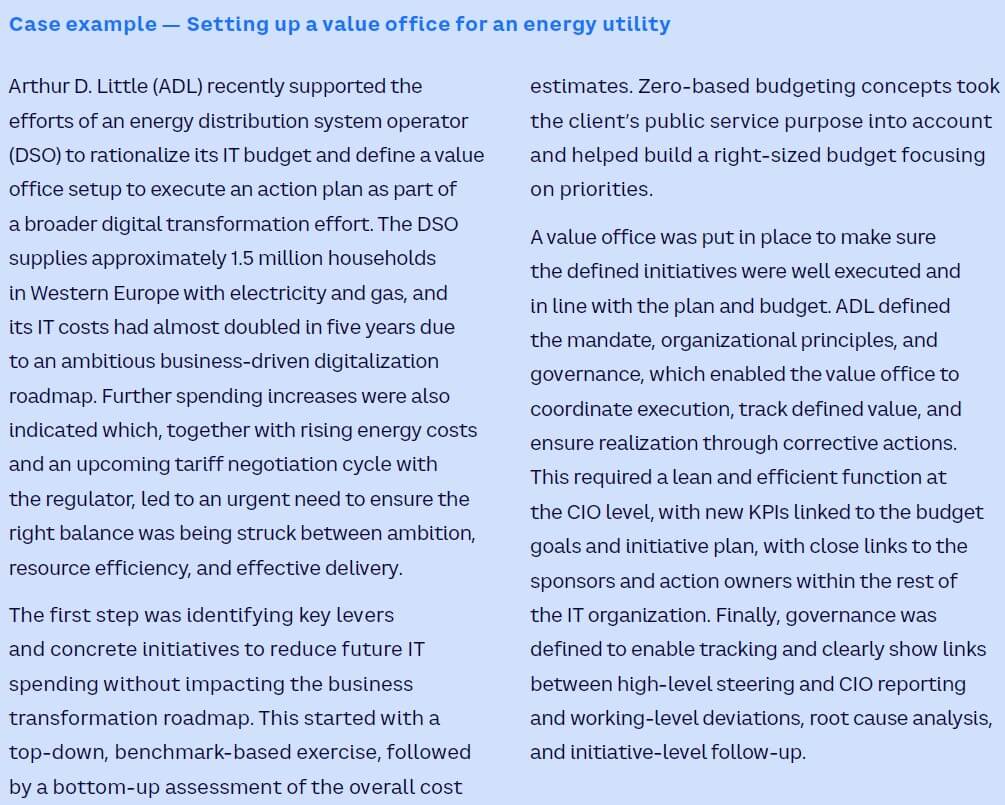
Despite two decades of accumulated experience, the majority of digital transformations still fail to meet expectations. The root causes typically relate to the often-difficult relationship between business and IT functions, resulting in the original strategic aims getting “lost in translation” during execution. In this Viewpoint, we explore how setting up a value office can help overcome common problems by tracking defined value and ensuring realization — leading to successful execution of the strategy.
WHY DIGITAL TRANSFORMATIONS STILL FAIL
Digitalization has revolutionized the business world and will continue to do so as technologies such as artificial intelligence, Internet of Things, and blockchain mature further. Digital transformation — a key part of the corporate agenda for two decades — has become an almost never-ending process for many organizations. So it is quite remarkable, with so much accumulated experience, that most digital transformations still fail to deliver their promised value. High-profile examples of unsuccessful transformations involving large corporations include Ford Motor Company and National Grid in the US, as well as countless public sector organizations. In the UK, an independent review conducted in late 2021 noted that many complex, large-scale digital programs were failing, despite government investments of £20 billion a year on IT transformation. In fact, some individual projects showed delays of more than five years and overruns of many hundreds of millions of pounds.
Ultimately, the problem is that digital transformation is very difficult, involving an increasingly complex mixture of technology, business processes, and people who work within a series of awkward legacy, operational, and budgetary constraints. Even though executives may be fully aware of the potential pitfalls at the outset, failures still happen because the original strategy and value proposition gets lost in translation during execution. There are several reasons for this, including:
- Business and IT functions struggle to collaborate successfully, with business viewing IT as the “guardian of legacy” and IT viewing business as the “unrealistic dreamer.”[1]
- Digital transformation emphasizes implementation of cloud, data, and analytics for cost or efficiency reasons without enough attention given to new ways of working, business models, or capabilities.
- The transformation roadmap lacks clarity of what successful business outcomes look like, how the outcomes link to corporate strategy, and what metrics should be utilized to monitor progress toward achieving them.
- Day-to-day tasks increasingly occupy managers and their teams, obscuring connections between execution activities and the original strategy. This is just as true in today’s pilot-based, fast-fail mode of digital execution as it was for traditional top-down implementation.
- The promise of new technology may distract senior leadership; afterward, they may be reluctant to admit failure and neglect to cut losses early enough when things start to go wrong.
- Unexpected constraints or burning operational issues take precedence, so initial aims need to be compromised and roadmaps become delayed.
- Changes in leadership during execution of a multiyear transformation, perhaps happening as a result of continued setbacks, can further contribute to lack of continuity between the original strategy and the reached outcomes.
It is standard practice to set up one or more dedicated offices to help manage the above issues during execution. For example, a transformation office steers and oversees overall program and change management; a program management office (PMO) tracks detailed program and project-level key performance indicators (KPIs) and provides a standard and repeatable methodology for project execution. However, both these vehicles tend to become inundated with day-to-day workload issues and problem resolution as execution proceeds, leaving insufficient time and attention to stand back and address the key question of whether, and to what extent, the original value proposition is still being delivered. Thus, setting up a dedicated value office is a powerful and effective way to address these problems and ensure that strategy and execution stay connected all the way through the transformation.
HOW A VALUE OFFICE CAN HELP
A value office comprises a small team mandated to ensure that strategy is properly executed through providing oversight, steering, and expert knowledge to embed change and to track the delivery of targeted value (see Figure 1).

The value office forms the linchpin connecting the digitalization transformation strategy with its execution. The office aims to ensure a transparent overall direction, collective responsibility for delivery between business and IT functions, tracked progress, embedded change, and, ultimately, ensure that the targeted value is delivered in practice. Key tasks include:
- Monitoring and tracking value realization, including progress toward reaching targets set out in the strategic plan.
- Creating transparent reports to create a clear picture of status versus strategic goals, which includes identifying blocking issues.
- Suggesting corrective steering measures to bring any deviations during execution back in line toward the desired outcomes.
- Aligning the people involved in the change, including empowerment and engagement, incentivization, and facilitating active and structured communication between parties, especially between business and IT functions.
The value office sits between a PMO and a transformation office, with a particular focus on and dedication to delivering value, as opposed to managing day-to-day execution of programs and projects. While a PMO is typically responsible for tracking project delivery and ensuring adherence to time, cost, and scope, the value office has a mandate on strategy realization and real value delivered. When setting up the value office, it is crucial that this difference in purpose is well understood. The terminology signifies to everyone in the organization that outcome realization, rather than project-delivery tracking, is what truly matters. As such, the value office also advocates for change in the way people think about value and outcomes.
The launch of the value office should start by articulating clearly the desired business outcomes, how these outcomes deliver business value, how IT supports their delivery, and what metrics should be used. Awareness of the range of dimensions of value that digitalization can bring is important. Efficiency and cost reduction are generally recognized first, but value can also be created through other dimensions, such as environmental, social, and governance (ESG) criteria and sustainability, and by enabling innovation in new business processes and business models.[2] Often, a hierarchical approach like a value tree helps organize ambitions into specific business outcomes and sub-outcomes, from which value drivers and finally KPIs can be derived. The next step involves defining a baseline and target values for the KPIs, articulating them in terms of a value roadmap, and securing agreements and commitments from all parties involved. Metric tracking, monitoring, and reporting systems can then be defined and institutionalized.
The human and organizational dimension is essential to complement hard metrics and data gathering. To ensure that people are properly aligned, the value office needs to separately engage with all key players involved, understand their motivations, and identify the triggers and barriers that determine how they are likely to behave. Using the above value articulation process itself as a vehicle for this engagement can help flush out and clarify barriers and misalignments. The value office should systematically identify such barriers and misalignments and propose suitable measures such as new communication approaches, specific incentives, empowerment initiatives, and best leadership behaviors, which may be necessary to support effective value delivery.
In practice, the process of defining the value roadmap, aligning people, monitoring and reporting progress, analyzing KPI deviations and their root causes, and identifying corrective actions is more iterative than linear. During the course of a major transformation, situations change and measures need to be periodically reviewed and refreshed, especially those relating to people aspects such as empowerment and incentivization, which can become stale over time.
SETTING UP A VALUE OFFICE
In practical terms, the size and nature of the value office clearly depends on the scale of the transformation program and the existing broader organizational structure and operating model. However, typically we recommend a small team, as shown in Figure 2.

A key feature is a dedicated high-profile value office lead, who oversees all aspects of the program, establishes suitable governance, coordinates across stakeholders, escalates risks, and drives alignment. In this illustrative example, the lead is supported by a value definition support manager who owns the business case as a single source of truth and defines the metrics, and a value tracking support manager who manages progress tracking and coordination with other functions, such as project management, finance, business units, and others. The team may also include a specialist support person who covers change management, for example, and additional administrative support personnel.
In terms of governance and reporting, ideally the value office should be integrated into existing frameworks. For example, the value office lead could either report into an overall transformation lead or have a direct reporting line to the C-suite. It is important that the rest of the organization views the value office as unbiased and not as an instrument of the business functions to “police” IT, or an arm of IT to keep the business functions at bay. Rather, the value office is a vehicle for bringing both together. The value office must be given enough delegated authority to resolve day-to-day problems itself, together with IT and business functions, rather than just advising and recommending. However, major issues may still require escalation.
In a typical setup, KPI data is gathered and reported monthly with quarterly value analysis and reporting to steering and/or investment committees. On an annual basis, business outcomes and value created are thoroughly reviewed, with re-baselining and target setting occurring as needed. Ideally, the value office should be set up early enough to participate in the strategic planning and target-setting process and to help articulate the business value of IT in an outcome-driven manner. This will greatly help ensure continuity and alignment during execution. The case example presented next illustrates how this model has been successfully applied in practice.

Conclusion
CONNECTING DIGITALIZATION & TRANSFORMATION STRATEGY
The value office model can help organizations avoid the common “lost in translation” pitfall by linking strategy to execution in complex digital transformation initiatives. Acting as a linchpin, the value office connects digitalization and the transformation strategy to execution. It aims to provide a transparent overall direction, create collective responsibility for delivery, track progress toward outcomes, embed change, and meet the ultimate goal of realizing the targeted value. This small team, typically organized as a neutral function reporting to the C-suite, is responsible for clearly articulating the desired business value and outcomes enabled by IT, while monitoring progress toward these outcomes and ensuring alignment and engagement at various levels. As with all such approaches, implementation is key to its success.
Notes
[1] For more details, see our Viewpoint “Business-IT-Partnership: It’s Complicated.”
[2] See our Viewpoint “Unleashing Innovation in IT” for more background on how IT creates business value.




